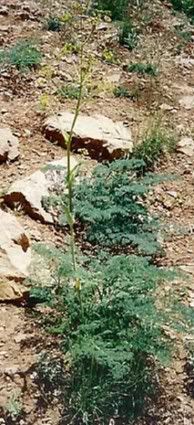

Asafoetida (Ferula foetida)
Folk Names: Asafoetida, Assyfetida, Devil's Dung, Ferula, Food of the Gods, Incense of the Devil
Description: Asafetida is a large Asiatic perennial found wild in Turkestan, Afghanistan, and Iran. It was first discovered in the Aral desert in 1844, but has been used since at least the twelfth century. It is a coarse plant with a large, bristly, fleshy root from which milky juice is collected periodically for incense. The stem of the plant may grow from six to ten feet surrounded by alternate, pinnately decompounded leaves on wide sheathing petioles, looking something like a cabbage. The pale green flowers appear at the top of the stem in clusters of many rayed umbels. The reddish-brown fruit is oval, flat, and thin.
Effects: strong
Planet: Mars, Pluto
Element: Fire
Associated Deities: Cernunnos, Pan, Priapus
Traditions:
According to Beyerl, there is an affinity between asafoetida and black diamond, and they should be stored together.
Asafetida contains a large amount of sulfur, giving its distinctive odor. The two are virtually interchangeable for magical purposes.
Magic:
Asafetida has been used as incense for exorcisms and protection nearly as long as sulfur. It destroys manifestation of spirit if thrown into fire during magical rites (if a spell is going wrong), and it may also be burned to make someone leave you alone. The herb may be added to self-purification rituals against negative habits. The power of any ritual (with the exception of spirit conjurings) may be increased with the addition of asafetida.
Known Combinations:
Used as an amulet, it will keep away colds and fever and evil. For this purpose, a small piece may be worn at neck and a clove of garlic can be added for extra protection.
To protect your home from evil spirits, make a cloth bag containing Asafetida, Valerian, Pepper, and Garlic. Sew it shut and nail it to your front porch ceiling or just above the entry to a room. Inside the entrance, place large mirror. This will cause demons to flee in terror.
In a small red bag, put some Asafetida and a lump of Sulfur. Anoint the bag with Camphor, and wear it around your neck. This will keep away vampires, werewolves, and the evil eye (along with all your friends).
Medical Indications: Parts Used:
juice and seed (not the resin reserved for incenses which is too volatile)
Asafetida is a large source of sulfur. Despite its odor (stronger than onion) and bitter taste, asafetida is used a great deal in India and the Middle East as a medicine. It is thought to stimulate the brain and is a known local stimulant of the mucus membrane, especially in the alimentary canal. This makes it useful for whooping cough, asthma, bronchitis, croup, and flatulent colic in infants. It is also used as a sedative for hysteria, infantile convulsions, and spasmodic nervous conditions.
Nutrition:
The natives of the high plains in Afghanistan eat the large, cabbage-like heads raw.
Mercantile Uses:
In addition to growing wild in the Middle East, Asafetida has been cultivated in the Edinburgh Botanical Gardens for some time.
In June, incense is harvested by a cut in the root of plants which have not flowered. The slashed root is left exposed but shaded for five to six weeks. Once the milky juice has dried, the reddish lumps are gathered and sent to Herat where they are adulterated before being sold. A very fine variety of asafetida is produced by the leaf bud in the center of the root, but this is never sold farther than India where it is known in bazaars as Kandaharre Hing. Kandaharre Hing appears in reddish flakes and gives off oil when squeezed.